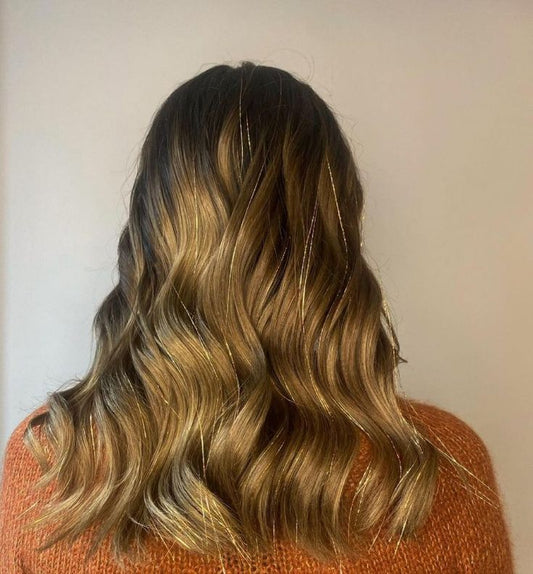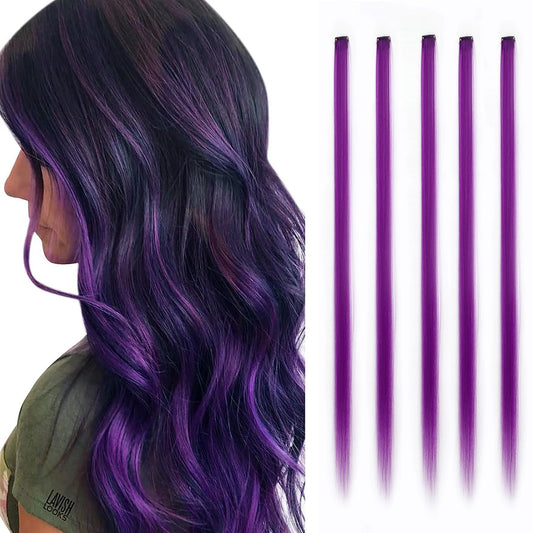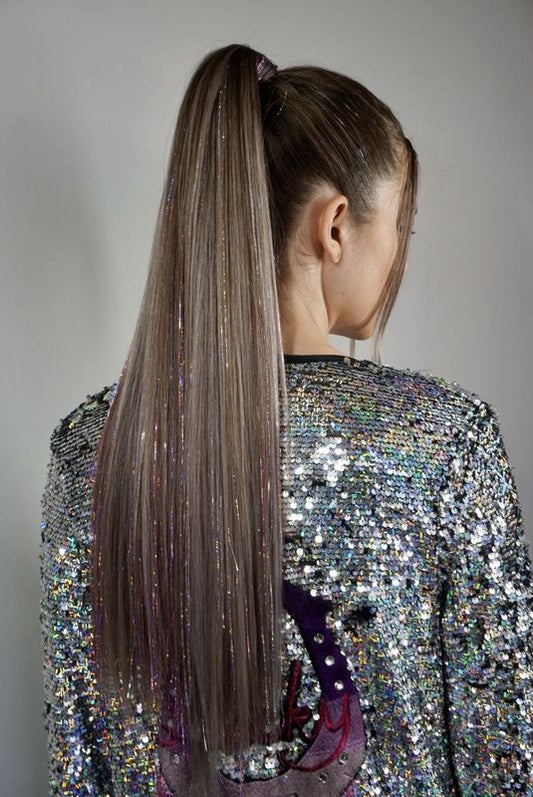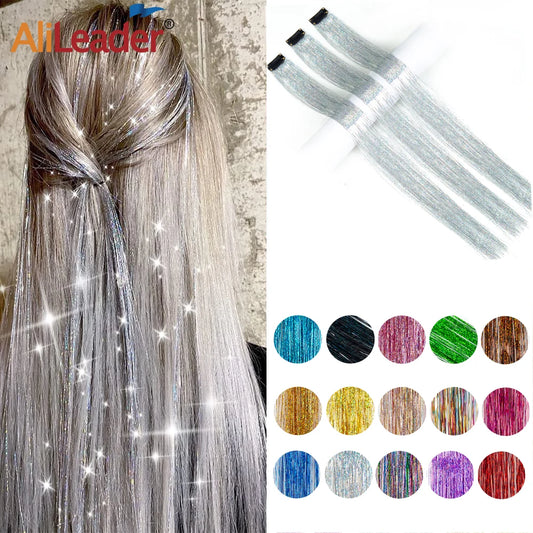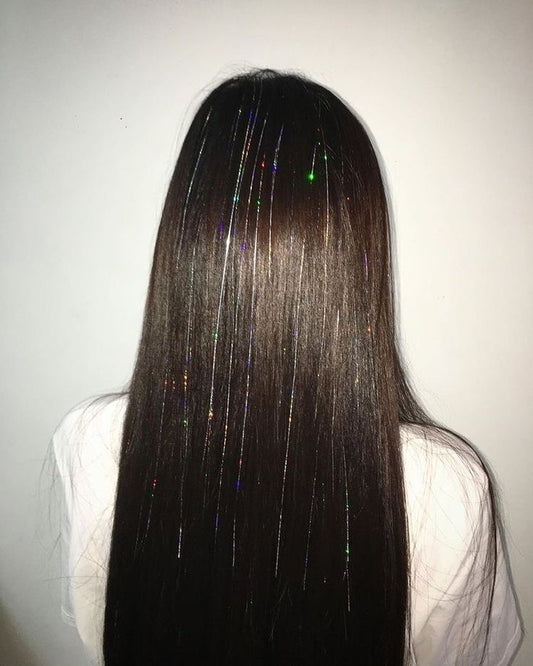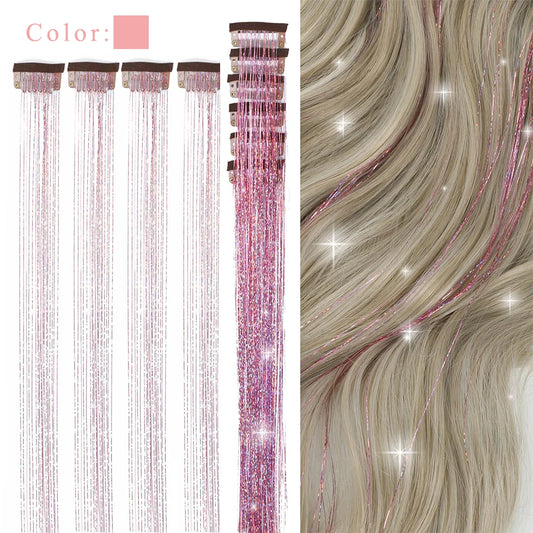Origins, Design, And Materials Of Modern Hair Tinsels
What Hair Tinsel Is And Why It Works
Hair tinsel is a slender, light-reflective filament designed to be anchored to individual strands or tiny bundles of natural hair, creating controlled flashes of color and shine without chemical processing or permanent commitment. By placing only a few threads within a section, stylists create a dimensional glimmer that reads polished in daylight and intensifies under evening or stage lighting—especially in motion, when the filaments angle and refract.
A Brief Timeline And Cultural Context
The idea of sparkling hair traveled through club culture and festival fashion in the late 1990s and resurfaced in the early 2010s with celebrity moments and tour styling; it has returned again with Y2K revival energy across TikTok and red carpets. Contemporary coverage tracks the resurgence to early 2025 fashion chatter as well as earlier celebrity sightings and mid-2010s tours, showing how the look cycles with nostalgia and performance aesthetics. citeturn0search3turn0search7turn0news46
How Tinsel Produces Its Signature Shine
The filament’s surface behaves like a micro-mirror. As you move, each strand catches and redirects light at slightly different angles, producing a crisp sparkle rather than a metallic block. Because the filaments are thin and semi-flexible, the effect blends with natural texture instead of masking it. In photographs, this reads as pinpoint highlights; in video, it adds kinetic shimmer.
Core Materials And Why PET Dominates
Most quality hair tinsel is cut from polyester film, commonly called PET or Mylar. PET offers a favorable stiffness-to-weight ratio, good color-fastness, and clean edges when slit into narrow widths. It also tolerates moderate heat and resists crumpling compared to cheaper plastic films, which is why reputable kits and salon packs specify PET-based fibers for durability and comfort. citeturn0search2turn0search18
Understanding Heat Resistance Ratings
Manufacturers list “heat resistant” for two reasons: PET’s glass-transition behavior and protective surface treatments that reduce deformation. Typical premium tinsels are rated for styling tool contact around 180–200°C (356–392°F), with some specialist suppliers claiming even higher thresholds for brief passes. The safest practice is to style at the lowest effective temperature and let curls set while cooling to lock shape with less heat exposure. citeturn0search4turn0search15
Cut, Width, And Finish Options
Filaments are usually slit to 0.1–0.3 mm widths and supplied in 36–48 inch lengths so a stylist can fold and trim. Finishes range from mirror metallics and holographics to subtle pearls and natural-match shades that echo balayage tones. Ultra-fine cuts deliver a flicker that reads editorial up close; wider cuts amplify stage sparkle.
Color Systems And Tone Strategy
Neutral metallics throw white light highlights; saturated jewel tones add playful flashes; iridescent and holographic finishes shift hue under changing angles. For dark hair, champagne, copper, emerald, and sapphire show best; for blondes, rose gold and opal avoid harsh contrast; on gray or silver hair, gunmetal and ice blue create cool sheen without skewing yellow. Mixed bundles—five to ten shades—give a custom, couture feel with minimal effort.
Design That Respects Hair And Scalp
The design brief for good tinsel is deceptively simple: low weight, smooth edges, colorfast surface treatments, and attachment methods that distribute stress. Filaments should be soft against the scalp, flexible enough to bend with the hair shaft, and strong enough to withstand brushing and gentle washing. Quality kits pair the filament with tools that avoid sharp crimps and minimize point pressure at the tie-in.
Installation Methods At A Glance
There are two mainstream methods. The tie-in technique anchors a folded filament to a single hair near the root with a slip knot; it is fast, discreet, and bead-free. The microbead method groups several filaments with a tiny silicone-lined bead that grips a small bundle of natural hairs; it speeds up volume installs and removal is simple with pliers. Both techniques can be learned at home, though salon installs guarantee tidy sectioning and tension control. citeturn0search7turn0search5turn0search9
An Editorial Eye On Placement
Editorial placement treats tinsel like jewelry. A few threads near the face create a soft glimmer in selfies; scattering strands through crown and mid-lengths yields a starry effect under downlighting; concentrated clusters inside a ponytail or braid read like hidden sequins revealed with movement. For modest fashion styling with scarves or turbans, tuck filaments so they peek at the hairline or ponytail wrap for a refined, intentional accent.
Texture, Length, And Density Planning
On fine, straight hair, keep density low so the result remains airy. Wavy hair benefits from slightly wider spacing but longer strands to catch light along the curve. Curly and coily textures shine with tinsel threaded into defined sections near the top layer so the sparkle emerges as curls bounce. For short cuts, place threads just behind the fringe or high at the crown so reflections sit where cameras find them.
Safety And Comfort Considerations
Tinsel is lightweight, nonpermanent, and should never feel tight or scratchy. Always test a few strands first to check tolerance and brushing behavior. Avoid very high heat, keep the knot slightly off the scalp for comfort, and direct airflow downward when blow-drying. If a bead or knot snags, remove and reapply—do not tug. Sensitized scalps may prefer fewer threads at a time.
Where It Fits In A Professional Wardrobe
Because tinsel does not alter your cut or color chemistry, it suits workdays and events alike. A micro-sparkle under a sleek bun looks polished in boardrooms and glamorous at dinners; a bolder scatter transforms festival hair without bleach. The look is also friendly to content creation—on video, the micro-reflections register as expensive and upbeat.
How This Collection Curates The Category
A well-edited collection matters for something as small as a filament. Fabulive prioritizes PET-based strands with consistent cut widths, salon-grade tools, and clear heat guidance so shoppers can build a kit that behaves predictably across textures, from soft waves to press-straight finishes. That curation reduces trial and error and makes the accessory feel couture rather than novelty for everyone from first-time wearers to backstage professionals.
Quality Markers To Look For
Reliability shows up in even edges, uniform width, and dye or metallic coatings that do not rub off when pinched between fingers. Premium filament springs back after a gentle bend instead of holding a kink. Spools or bundles should arrive free of dust and with protective sleeves; kits should include a threader, microbeads with silicone lining if applicable, and clear, stepwise instructions you can follow without guesswork.
Heat, Tools, And Professional Discipline
While PET tinsels are frequently advertised as heat resistant, responsible styling treats them as accents, not as the main heat carrier. Set irons to conservative ranges, pre-dry with downward airflow, and let shapes cool on clips instead of baking passes into the hair. For waves, wrap the natural hair around the barrel and allow the tinsel to follow rather than pinching the filament directly between plates. This method preserves crisp edges and color for more wears. citeturn0search4
Compatibility With Existing Extensions
Tinsel can coexist with clip-ins, halos, tapes, wefts, and fusion bonds when placed between attachment rows and kept away from adhesive tabs. Use the tie-in method near tape systems to avoid extra bulk and the microbead method inside sew-in tracks where there is room to conceal hardware. The delicate scale of tinsel means the finished style remains light and comfortable even when layered over extension installs.
Colorfastness And Water Exposure
High-quality coatings resist color bleeding in fresh and salt water, but pool chemicals can dull metallic finishes over time. Rinse after swimming and pat dry rather than rubbing to protect both the filament and your cuticle. If you frequent chlorinated pools, rotate neutral metallics and pearlescents—which tend to maintain appearance longer—through the season for a consistent look.
Testing Before A Big Event
For shoots and weddings, practice a week ahead. Install a small cluster, wear it through a normal wash and brush routine, and note any adjustments you want in spacing or length. Photograph in daylight and under evening light so you can decide whether to add more threads, change colors, or refine placement for the venue’s lighting plan.
Packaging And Storage Discipline
Coil bundles loosely and store flat in resealable sleeves to prevent edge wear. Keep tools with the filament so your next install is quick. If you cut custom lengths, label envelopes by shade and length to speed future touch-ups. A tidy kit is a professional time-saver whether you are a stylist or a meticulous enthusiast.
Design Ethics And Age Inclusivity
Because tinsel reads as jewelry, it welcomes a wide range of ages and roles. It can be subtle on executives, playful on students, and celebratory on brides without shifting haircut identity. That inclusivity is why stage performers, teachers, and healthcare professionals have all adopted discreet placements that hold under motion yet stay office-friendly.
Editorial Pairings And Palette Direction
Treat tinsel as a finish layer. Pair cool metallics with blue-red lip tones and silver jewelry; match warm metallics to gold hardware and beige tailoring; reserve holographic shades for nightlife, K-pop-inspired looks, and festival lighting. When your wardrobe leans minimalist, a micro-sparkle at the temple or inner layers of a ponytail delivers lift without adding visual noise.
Sourcing Confidence And Responsible Choice
A curated marketplace reduces uncertainty around coatings and base films. Look for clear statements about PET composition, approximate temperature guidance, and accessory quality so your install behaves predictably at home and in the chair. That is precisely the promise of Fabulive’s selection: streamlined options that privilege consistency, comfortable wear, and transparent specifications without overwhelming shoppers with near-duplicates.
Lighting Notes For Photographers And Creators
Because the filaments reflect hard specular highlights, they photograph best with diffused key light and a gentle hair light from behind to articulate movement. On phones, switch off aggressive beauty filters that flatten sparkle into noise; instead, use 24–30 fps video and let the micro-reflections travel as you turn. Under stage LEDs, stack two or three complementary shades so the camera registers color shifts rather than a single metallic glare.
In office lighting, fewer strands near the face maintain polish while staying understated.
Application Mastery, Styling Systems, And Maintenance For Everyday And Event Hair
Preparation And Sectioning Discipline
Begin with clean, fully dry hair. Create stable bases by sectioning horizontally from nape to crown, clipping each panel. For tie-in, select a single strong hair or a tiny bundle; for microbead, gather three to five natural hairs. Maintain even tension—not tight—and position knots or beads two to four millimeters from the scalp so they flex naturally with head movement and minimize friction during sleep and brushing.
Tie-In Method: Precision Steps
Fold the filament at its midpoint. Loop the bend around the anchor hair, then pass the tails through to create a lark’s head knot. Slide the knot to position, tighten gently, and trim tails to the desired length. For longevity, install two to three knots per micro-section; for quick weekend sparkle, one knot suffices. Practice on a mannequin or a back panel of your own hair before working around the face so muscle memory is clean.
Microbead Method: Speed And Symmetry
Load a threader with the bead, catch a small bundle of hairs, pull through the bead, insert two to five filaments, and crimp softly with pliers. Angle beads to follow your natural growth pattern so they lie flat. This method is efficient for color gradients and ponytail clusters; removal is quick with reverse pressure on the bead.
Strategic Placement For Different Cuts
Bob And Lob: Concentrate threads internally near the crown for a Lumière effect and keep the perimeter almost bare to preserve a sharp outline. Layered Cuts: Stagger lengths so filaments shimmer at multiple planes; avoid placing them exactly at layer breaks. Long One-Length: Use interior placements from eyebrow to collarbone heights; a few face-framing strands create camera-ready lift without changing cut geometry.
Color Mapping And Shade Harmonies
Match metallic temperature to jewelry and undertones: golds and coppers flatter warm complexions, silver and gunmetal flatter cool. Jewel tones—ruby, amethyst, sapphire—read playful; opal, rose gold, and champagne whisper luxury. Blend two complementary tones for subtlety or mix five for editorial drama. Keep ratios intentional (for example, four champagne to one emerald) so the palette feels designed.
Texture-Specific Guidance
Straight Hair: Moderate density and precise alignment; two to four strands per section is plenty. Wavy Hair: Slightly more volume and longer cuts; the curve exaggerates sparkle. Curly Hair: Install near top layers and avoid fragile baby hairs; set curls with low heat or diffuse so filaments coil naturally. Coily Hair: Use beaded installs within stable coils, prioritize silk sleep protection, and keep density low near edges to respect tension.
Brushing, Washing, And Sleep
Brush from ends upward while supporting the base with your fingers. Shampoo scalp only, letting lather migrate; condition from mid-lengths to ends. Blot with a microfiber towel, direct airflow downward, and sleep in a low braid or pineapple with a silk scrunchie and pillowcase. These frugal habits dramatically reduce snagging and preserve crisp filament edges.
Heat Styling Without Melting Or Warping
Use the lowest temperature that changes shape and keep contact brief. For irons, treat tinsel as a passenger on the natural hair, not the primary heat target; the natural fiber buffers brief heat. For blowouts, a concentrator plus round brush sets alignment without pressing metal onto filament. Clip-set curls while cooling to lock shape at lower temperatures; this pro trick delivers more longevity for less risk.
Upstyles, Braids, And Ponytails
Place small clusters inside ponytails so sparkle reveals on movement. For braids, anchor filaments in the outer sections so they appear at each crossover. In buns, insert on the outer ring for a halo effect. With French twists and chignons, hide threads at the seam so they peep in a strobe rather than a constant streak.
Office, Ceremony, And Festival Modes
Office Mode: Two or three champagne or rose-gold strands near the face. Ceremony Mode: Add a mid-crown scatter and braid accents; keep tones consistent with jewelry. Festival Mode: Layer holographic and jewel tones with denser clusters at the crown and ends; secure with lightweight spray for camera sparkle that lasts through dancing.
Care Timelines And Wear Windows
Tie-in installs typically sit comfortably for seven to fourteen days, shedding naturally as anchor hairs move through their cycle. Microbead clusters may last longer with careful brushing. Replace threads as they migrate or snag. If you are heat-styling daily, expect to rotate fresh filaments weekly to maintain crisp edges and true color.
Troubleshooting Guide
Slippage At The Root: Reinstall farther from the scalp or tighten gently. Stiff Feel: Too many threads in one micro-section; remove a few. Dullness: Product film or pool exposure; rinse, clarify the hair—not the filament—and reinstall new pieces if the finish is compromised. Tangles: Increase silk protection at night and reduce density near the nape.
Hard Water, Pool Days, And Travel
Mineral-rich water dulls shine through surface film. Keep a chelating rinse on hand and use it on hair as needed; dry thoroughly and reassess. Before pools or open water, saturate hair with fresh water, braid, and rinse soon after. On trips, store pre-cut threads in labeled envelopes with a tiny kit—threader, beads, pliers, and scissors—for fast refreshes.
A Creative Director’s Styling Menu
Minimalist Spark: Two near-temple accents matching metal jewelry. Gilded Midday: Six threads scattered across crown and mid-lengths in champagne and copper. Night Electric: Iridescent cluster under a deep side part with hidden threads in a loose wave set. Runway Pony: Dense bead cluster inside a high tail to flicker under backlight. Bridal Veil: Micro-threads under a veil line so they reveal during turns and first dances.
Inclusive And Modest Styling
For covered styles or partial coverage, position tinsel along the hairline and at ponytail exits so the sparkle remains intentional yet respectful. Under turbans, target the nape bun and sideburn areas for brief flashes that read elegant rather than loud. This design-first thinking lets the accessory complement, not compete, with cultural dress.
Professional Hygiene And Kit Maintenance
Wipe pliers and threaders with alcohol after each session, keep beads sealed to avoid dust, and replace any bent tools. Clean work surfaces, wash hands between clients, and store filaments away from sprays so coatings stay pristine.
Performance And Content Creation
For creators, treat tinsel like a highlight reel. Capture slow head turns, backlight the crown, and use medium frame rates that preserve specular flicker. On live stages, ask for a soft hair light; in studios, position a small reflector low to bounce into the mid-lengths. The aim is a controlled glow that never looks plasticky.
Budgeting And The Value Equation
Tinsel is a high-impact, low-commitment accessory. A single kit can fuel multiple looks, and installs require minutes once you have rhythm. When amortized across weekends, shoots, and events, cost per wear is tiny compared with color appointments or accessories you only wear once. That calculus is why stylists keep it in the kit for emergency lift.
Sustainability Considerations
While PET is a plastic, many suppliers are migrating toward recycled content and improved coatings; the most sustainable move you can make is reusing tools, storing filaments carefully, and installing fewer threads with better placement. When you do discard spent pieces, collect them in a small container rather than letting loose strands travel to drains or outdoor spaces. Industry programs for polyester recovery and circularity continue to expand, signaling a more responsible future for performance films. citeturn0search12turn0search10turn0search16turn0search20
Curated Shopping With Confidence
A streamlined catalog makes it easy to pick shade sets, tool types, and lengths without second-guessing. That is the role of Fabulive in this category: a clear path from idea to kit, with options that align to real-world styling behaviors and straightforward installation notes for first-timers and pros alike.
FAQs For Perfect Results
How Many Strands Do I Need? Ten to thirty individual tie-ins or three to six microbead clusters suit most looks; editorial density may double that for shoots. How Long Do Installs Last? Tie-ins are commonly worn for up to two weeks, microbeads somewhat longer with careful care. Can I Heat Style? Yes, at conservative settings and brief contact, treating tinsel as a passenger on the natural hair. Does It Work On Curly And Coily Hair? Yes, with low density, section-aware placement, and silk sleep protection. Is It Office-Appropriate? Choose subtle tones and minimal placements; the effect reads polished in daylight and discreet in meetings.
Brand Placement And Aftercare Messaging
Labels should state PET composition, approximate heat guidance, and clear instructions illustrated step by step. Short care cards fit into kits and train muscle memory quickly. Fabulive emphasizes this clarity so customers understand where and how to place threads, how to sleep, and how to refresh for the next event.
Editorial Pairings With Makeup And Wardrobe
Cool metallics flatter taupe shadow, berry lips, and silver hoops; warm metallics echo bronzed cheeks, beige suiting, and gold chains. Jewel tones sparkle against black tailoring and evening satins, while opal and rose gold harmonize with daytime cottons and silk blouses. Keep one element bold—lip, liner, or sparkle—so the composition remains luxe.
Safety And Sensible Caution
Keep installs away from toddlers’ hands and pets, avoid open flames, and ventilate rooms when heat styling over products that contain volatile silicones or solvents. As with any hair accessory, if irritation or tenderness occurs, remove the piece and let the area rest. Conservative choices compound into long, comfortable wear.
Where This Retailer Elevates The Experience
Beyond supplying filament and tools, Fabulive presents thoughtful bundles—neutral metallics, brights, and holographics—paired with right-sized bead packs, threaders, and storage sleeves. That means fewer carts, fewer returns, and faster success for shoppers building kits for offices, weddings, festivals, or stage work.
Quality Control Checklist Before Checkout
Confirm strand length and width, verify bead inner lining is silicone, ensure the threader matches bead size, and read heat guidance printed on the kit—ideally specific temperatures rather than vague claims. Scan return policies for hygiene rules. Finally, test a single shade against natural hair under daylight and warm indoor light to confirm tone harmony before opening all packets; this small pause prevents waste and streamlines your first install.
Sustainability, Long-Term Value, And Expert FAQs For Hair Tinsel Buyers
Why Tinsel Earns A Place In A Professional Kit
Tinsel occupies a useful niche between accessories and cosmetic color. It offers event-level impact with negligible weight, finishes a look without product buildup, and removes in seconds when the mood changes. For stylists, it solves last‑minute brief changes: add a champagne flicker to harmonize with jewelry, or tuck holographic accents under a braided crown to energize stage lighting. For everyday wearers, it is a mood elevator that respects haircut integrity and hair health.
Sustainability And Responsible Use
Polyester film is a plastic, which means responsible use matters. The path forward is threefold: buy durable PET filaments, use fewer threads with smarter placement, and store unused pieces for future reuse. Industry initiatives around PET film recycling and circularity are expanding, and many suppliers now communicate recycled content and process controls in their technical literature. Consumers close the loop by collecting spent strands rather than letting them escape outdoors or down drains; a small container in your kit makes that easy. citeturn0search10turn0search12turn0search20
Disposal, Reuse, And Kit Hygiene
Discarded threads should go into sealed household waste or specialty plastic recycling streams where available. Never flush strands. Reuse is often practical: if a piece remains glossy and straight after removal, wipe it, coil it loosely, and store it for another look. Replace tools that bend or lose tension so beads crimp cleanly; clean pliers and threaders with alcohol between clients to maintain salon hygiene.
Budget And Cost Per Wear
A multipack of filaments paired with a small bead kit can fuel dozens of refreshes. If a single install of twenty tie‑ins lifts your confidence for a two‑week project sprint, the cost per day is minimal—often lower than a single latte. Compared with chemical highlights, tinsel’s value equation is compelling because there is no grow‑out line, minimal maintenance, and zero color correction.
Event Planning And Creative Direction
Work backward from lighting conditions. Day parties benefit from opal and champagne, which sparkle softly; evening events welcome holographic and jewel tones that react dynamically to LEDs. For cameras, design a focal area: near the face for portraits, across the crown for overhead angles, or in a tail for full‑length shots. Rehearse the head turn you want photographed and ensure strands sit where the lens catches them.
Frequently Asked Questions
How Long Does Hair Tinsel Last In Real Life?
Tie‑ins commonly last about one to two weeks, depending on brushing and sleep habits; microbead clusters may wear longer if you protect edges with silk overnight and support the base while detangling. Replace strands that migrate below their ideal position so your placement stays intentional. citeturn0search7
Can I Use Hot Tools With Tinsel?
Yes, with restraint. Style at conservative settings and keep contact brief. Treat tinsel as a passenger on natural hair so the fiber buffers heat. The safest approach is to pre‑dry with downward airflow, set shape with a round brush, and use minimal iron passes only where needed. citeturn0search4
Does Tinsel Work On Curly, Coily, And Highly Textured Hair?
Yes. Use low density, place near the top layer, and avoid fragile baby hairs. Bead installs inside stable coils are comfortable; sleep with silk protection to prevent abrasion. Diffuse on low heat so filaments follow the curl pattern without tugging.
Is Tinsel Appropriate For Professional Settings?
A handful of subtle champagne or rose‑gold strands near the temple or behind the ear reads like fine jewelry and remains office‑appropriate. The key is discipline in quantity and tone. Save holographics and saturated brights for evening or weekend modes.
Will Tinsel Affect My Existing Extensions Or Color?
When installed between attachment rows and kept away from adhesive tabs, tinsel coexists happily with clip‑ins, halos, tapes, wefts, and fusions. It adds sparkle without disrupting color formulas, which is helpful when you want seasonal contrast without touching bleach or dye.
Can Children Wear Hair Tinsel?
Yes, with supervision and gentle placement. Keep sections small, avoid sensitive hairlines, and skip heat tools entirely for younger wearers. Removal should be smooth: uncrimp beads or slide knots open rather than pulling.
How Many Colors Should I Choose For My First Kit?
Two tones create intentionality and are easier to balance; five‑shade assortments amplify drama for festivals and shoots. Start with a warm or cool metallic aligned to your jewelry, then add one accent color for contrast.
What Length Should I Buy?
Forty‑plus inch strands provide flexibility because they can be folded and trimmed to suit short and long cuts. If you only plan to accent a bob or lob, thirty‑six inches may suffice. Long strands are more versatile for ponytails and braids because you can leave tails extended for movement.
What’s The Best Way To Sleep With Tinsel?
A loose braid or pineapple with a silk scrunchie and pillowcase minimizes friction. Avoid sleeping with wet hair; water‑swollen fibers are more vulnerable to stretching and tangling, so dry thoroughly first.
What If A Strand Catches Or Feels Scratchy?
Remove it and reinstall. Do not tug; friction damages cuticles and can distort the filament edge. If a bead catches, reverse‑crimp and slide out; if a knot tightens in the wrong spot, cut the filament and release pressure immediately.
How Do I Photograph Tinsel Beautifully?
Use soft, diffused light and a subtle backlight to reveal the shimmer without harsh glare. For phones, choose 24–30 fps video and let the sparkle travel as you turn; for stills, angle your head so a tiny rim light kisses the filaments at mid‑lengths.
The Editorial Capsule Wardrobe For Tinsel
Day Minimal: Two champagne threads at the temple with silver hoops. Presentation Ready: Four champagne and copper accents scattered through the crown and mid‑lengths. Night Luxe: Iridescent cluster beneath a deep side part, paired with satin or sequins. Destination Weekend: Jewel‑tone threads braided into a high ponytail for quick changes from day to night.
Why The Trend Endures
Beyond nostalgia, the accessory endures because it delivers joy with nearly zero learning curve. It offers personal expression, photographs beautifully for social content, and accommodates diverse hair types, dress codes, and cultures. As fashion cycles swing from maximalism to restraint, tinsel adapts: a whisper for weekdays, a glow for weekends, and a burst for stages.
How Retailers Support Good Outcomes
Clear labeling, conservative heat guidance, and tool kits sized to real use make the difference between a smooth first install and frustration. Merchandising that groups shades by undertone and occasion simplifies selection; concise care cards turn beginners into confident users in minutes. Those small design choices are the invisible scaffolding behind polished results.
Ten Customer Reviews
• Madison K., USA: I added six champagne strands near my part for a corporate event and kept them in for a week without any snags; the effect felt refined on camera and easy in real life. ⭐⭐⭐⭐⭐
• Oliver P., UK: The microbead kit made installation tidy and quick, and the included threader finally matched bead size correctly; my crown scatter held through two spin classes. ⭐⭐⭐⭐
• Sofia H., Canada: I used opal and rose gold for daytime meetings, then layered holographic pieces for a concert; the switch looked intentional instead of loud. ⭐⭐⭐⭐⭐
• Aisha R., UAE: Tie‑ins on my natural curls were comfortable, and a silk bonnet kept everything smooth overnight; the shimmer peeked out beautifully under abaya styling. ⭐⭐⭐⭐⭐
• Emilia V., Italy: I tested a few shades in daylight first and avoided harsh contrast; the subtle pearl tone was elegant with gold jewelry and beige tailoring. ⭐⭐⭐⭐
• Noah S., Australia: The bead pliers felt sturdy and the strands stayed crisp even after a beach day and a careful rinse; great value per wear. ⭐⭐⭐⭐
• Léa M., France: I layered emerald with champagne for a gala and the effect under stage LEDs was cinematic; quick removal saved time after the event. ⭐⭐⭐⭐⭐
• Hannah W., Germany: I kept heat low and treated the filament as a passenger on my blowout; edges stayed smooth and there was zero plastic smell. ⭐⭐⭐⭐⭐
• Layla N., Saudi Arabia: The curated color sets made it simple to match my jewelry; installation took minutes and looked polished under soft evening lighting. ⭐⭐⭐⭐
• Ava J., Netherlands: A small kit in my bag meant fast touch‑ups on travel days; the design notes about sectioning and sleep protection were spot on. ⭐⭐⭐⭐
Material Science Snapshot
Polyester, the base of most tinsels, is valued for tensile strength, dimensional stability, and the ability to hold vapor‑deposited metallic layers cleanly. Those properties explain why narrow, hair‑scale strips resist fraying even under brushing and mild heat when installed and maintained with care. Emerging supply chains are increasing the percentage of recycled PET in specialty films without sacrificing performance, and several film producers now publish circularity roadmaps aligned with broader sustainability goals. citeturn0search12turn0search20turn0search16 citeturn0search16turn0search20turn0search12
Salon Education And Compliance
For professionals, the best outcomes come from clear pre‑service consults: confirm length goals, shade palette, and lifestyle factors like workouts or swim schedules. Discuss sensible densities and sleep routines, document home‑care steps on the receipt, and offer a quick removal policy if a client experiences tenderness. These small procedural touches turn a novelty into a reliable service category.
Checklist For Your First Kit
Strands: 36–48 inch PET filaments in two coordinated tones. Tools: Matching threader and microbeads with silicone lining, plus pliers and sharp scissors. Care: Microfiber towel, silk scrunchie, and a pillowcase to reduce friction. Guidance: Printed heat notes, placement diagrams, and a simple removal guide. Storage: Resealable sleeves labeled by shade and length so you can refresh in minutes at home or on the road.
Sustainability In Daily Practice
Collect spent threads in a small container and dispose of them responsibly; reuse intact pieces after wiping them clean. Keep density lower but placement smarter to achieve impact with fewer materials. Favor suppliers that disclose PET content and heat guidance, and reuse tools season after season. Over time, these habits reduce waste while preserving the joy that makes the accessory so appealing.

